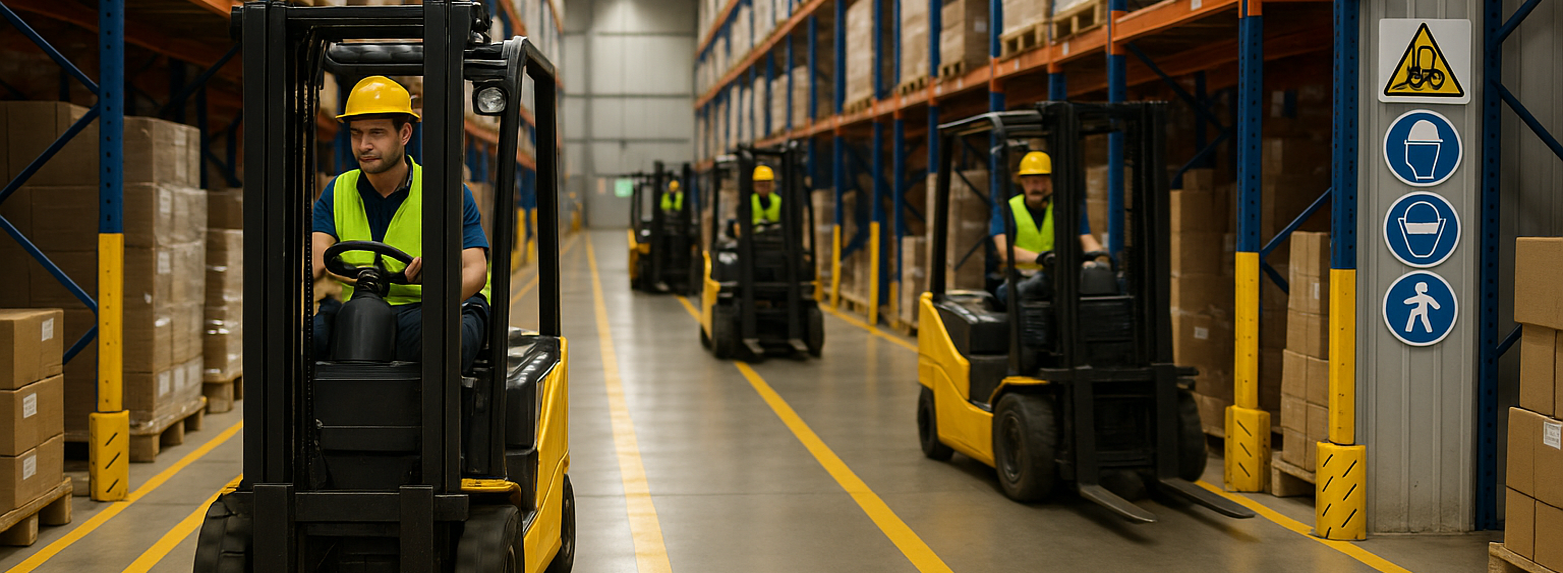Forklift Safety Guide
Posted by Zing Green Safety Products on Aug 18th 2021
Forklift Safety Guide
According to the National Safety Council, forklifts cause nearly 40,000 injuries and 100 fatalities each year, with significant property damage from improper use. Key hazards include tipping, falling or striking incidents, falling loads, and dock-edge events — most fatalities occur during tip-overs. This guide covers truck types, core components, operating stability, inspection and maintenance, refueling, lockout/tagout, and safe driving practices.
Introduction
Potential hazards include tipping, falling or crushing incidents, falling loads, and driving off docks. Most fatalities occur when forklifts tip. Understanding truck types, components, and the stability triangle helps prevent these events.
Types of Lift Trucks
Lift trucks are categorized by power source: Gasoline (G), Diesel (D), Propane (LP), or Electric (E). Match the power source to your environment—e.g., gasoline units are hazardous in flammable atmospheres.
Components of a Lift Truck
The Body
- Wheels
- Counterweight — rear metal mass for stability/weight distribution
- Seating area & overhead guard — protects from falling objects (hard hat may still be required)
- Control panel — fuel/charge, hour meter, oil pressure, engine temp
- Controls — steering, brakes, accelerator; directional control; lift/tilt; fork width; horn & lights
- Data plate — fuel category & weight limits; must be legible
The Hydraulic Lift
- Lift & chains — routed over chain wheel to raise carriage
- Mast — vertical assembly for lifting/tilting/lowering
- Forks — prongs for pallets; adjustable width
Operating a Lift Truck: Stability
The most common danger is instability. A lift truck has three points of suspension (two front wheels and the center of the rear axle). Lines drawn between them form the stability triangle. Keep the center of gravity inside this triangle.
Load capacity & placement: Never exceed the data plate rating. Keep loads low and close to the front (fulcrum = front wheels). Tilt slightly back when traveling. For unbalanced loads, place the heaviest side nearest the fulcrum.

Maintenance & Inspection
Keep trucks clean of oil/grease/dirt. Wipe down daily. Inspect before each use and tag/sign/date records.
Maintain pressure; check for punctures/splits to avoid uneven operation and tipping.
Protects from falling materials; reduces head-impact risk in tip-overs.
No leaks; forks not bent/damaged. Faults can create falling-load hazards.
Propane: secure & leak-free. Battery: no corrosion/leaks; sound insulation/wiring.
Brakes, steering, horn, lights, seatbelts must function correctly.
Driving Hazards
Warehouses present pedestrians, low ceilings, sharp corners, slick floors, docks, and electrical lines. Drive slowly, yield to pedestrians, and keep a stopping mindset. Know your route but expect surprises (spills/obstructions).
Refueling
Use designated, ventilated areas with appropriate emergency equipment. No sparks/open flames/smoking.
Changing Batteries
- Authorized personnel only; shut power; wear PPE (chem-resistant gloves, glasses, footwear, apron).
- Disconnect battery; inspect for missing caps/covers, damaged insulation.
- Remove to charging station; install new battery; secure connections.
Changing Propane Tanks
- Authorized personnel; neutral control; PPE (glasses, temp-resistant gloves).
- Close service valve; bleed hose; power off; swap tanks in storage/bracket.
- Inspect hose; hand-tighten to valve; lock bracket; open slowly; if propane odor, reseat/reseal.
Gasoline/Diesel
- Ventilated area with fire protection; engine off; wear glasses (gloves recommended for diesel).
- Refuel carefully; replace cap firmly; clean any drips immediately.
Lockout/Tagout
Before maintenance/repair, follow OSHA’s written LOTO procedures (six-step hazardous energy isolation). Forklifts may include electric, hydraulic, kinetic, and gravitational energy sources.
- Electric (battery): remove negative terminal; apply plug lockout.
- Propane: dissipate energy; set tank to OFF; lock out valve.
- Hydraulics: fully lower mast; dissipate residual pressure.
Conclusion
Forklifts are essential — and hazardous without disciplined controls. Build a program aligned to OSHA 1910.178, reinforce training, and audit routinely. More information: OSHA Powered Industrial Trucks.

